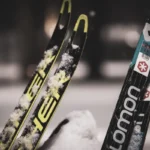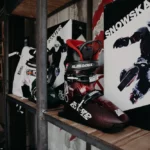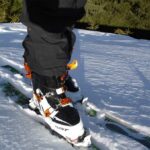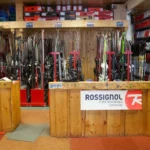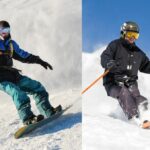Understanding Ski Types
In modern skiing, two main styles have become prominent, each with distinct equipment optimized for performance. They offer unique experiences on the snow, shaped by their design and intended use.
Classic Skis vs. Skate Skis: Core Differences
Classic skis and skate skis serve different purposes within cross-country skiing. Classic skis are longer, with a dedicated grip zone underfoot for traction during the kick-and-glide motion on groomed tracks. They sometimes require waxing in this zone to match changing snow conditions. In contrast, skate skis are shorter and stiffer, lacking a grip zone since propulsion is achieved through a side-to-side skating motion on firm, groomed snow.
Key Comparisons:
- Length: Classic skis are generally longer for stability and glide, while skate skis are shorter for maneuverability.
- Width: Skate skis are wider to provide increased stability during lateral movements.
- Waxing: Classic skis may need kick wax, whereas skate skis are typically waxed only for glide across the entire base.
Historical Evolution of Skiing Styles
The history of skiing reveals the evolution of styles, leading to today’s equipment choices. Classic skiing dates back centuries, utilizing a straight-line motion that mimics walking or running. It is the foundation upon which the sport was built. Over time, as skiing techniques advanced, skate skiing emerged, influenced by the dynamics of ice-skating. This style requires skis specifically designed to handle the demands of powerful lateral movements and rapid strides. With both styles, advancements in materials and engineering have refined ski design, contributing to the efficiency and popularity of these winter sports activities.
Anatomy of a Ski

Understanding the anatomy of a ski is essential for recognizing how design, materials, and specific features contribute to the performance of classic and skate skis.
Design and Structure
The design and structure of a ski are critical for its function in different skiing disciplines. A ski typically comprises a tip and tail, which are the front and end points, respectively. The sidecut refers to the hourglass shape that influences turning capabilities. Camber is the arc-like curve noticeable when the ski is placed on a flat surface, which affects the distribution of weight across the length of the ski. The edges run along the sides of a ski, with their sharpness and angle playing a role in traction and control during a descent.
Materials and Technology
Advances in materials and technology have greatly improved ski performance. Skis are made using a variety of materials, including wood, fiberglass, carbon fiber, and metal. The combination of materials used often dictates the ski’s stiffness and flex, which are critical to how the ski reacts to various snow conditions and pressures. Technologies are also implemented to enhance the grip zone on classic skis, which is integral for providing the traction needed for forward motion.
Classic Ski Features
Classic ski features are specially designed for a smooth and efficient in-track experience. The grip zone, located underfoot, can be either waxable or feature a built-in fish scale pattern to help the ski grip the snow during the kick phase. Classic skis are generally narrower and longer than skate skis, with a gentler sidecut. This construction is optimized for straight-line gliding and stability.
Skate Ski Features
In contrast, skate ski features cater to the needs of a more aggressive and dynamic skiing style. Skate skis are shorter and wider for enhanced stability during the side-to-side skating motion. They often have a stiffer camber to support the additional force applied during pushing off. The tail of the skate ski is usually stiffer than that of a classic ski, aiding in powerful propulsion and quick directional changes.
Skiing Techniques and Styles

Cross-country skiing encompasses two predominant styles – classic and skate skiing – each with their unique technique and suited to different terrains.
Classic Skiing Technique
Classic skiing employs a diagonal stride technique that mimics the natural motion of walking. The skis move parallel to each other with a forward and back gliding motion. The key lies in the kick and glide — a skier propels forward by kicking down and back on the grip zone of the ski, then gliding forward on the other. Efficient classic technique requires synchronization of arms and legs, which involves the use of opposite limbs; when the left ski is forward, the right arm swings forward, and vice versa. This necessitates balance and coordination, engaging a variety of muscles in the arms, legs, and core.
Classic skis are designed for this specific technique, with a longer and more flexible structure to facilitate straight-line gliding. They often feature a grip zone, which may be either waxable or equipped with scales or skins, to aid in the kick phase that drives the skier forward.
Skate Skiing Technique
Skate skiing, in contrast, is characterized by a side-to-side motion that is more akin to ice skating. Skiers push off the edge of each ski in a V-shape to gain momentum. This technique is more vigorous and requires a higher degree of balance and core stability. It engages different muscle groups, particularly in the legs and core, due to the lateral movements and continuous pushing motion.
Skate skis are generally shorter and wider than classic skis to support this dynamic movement. They allow for quick, responsive actions that facilitate the skating technique. The absence of a grip zone means that the propulsion comes from the edges of the skis.
Choosing the Right Technique for Terrain
The selection between classic and skate skiing often depends on the terrain. Classic skiing is well-suited for groomed trails with set tracks, being the traditional choice for undulating terrains where a steady rhythm can be maintained. Conversely, skate skiing is ideal for packed, wide trails where there is ample room for the sweeping, side-to-step motions.
Each technique has its own charms and challenges, and skiers may choose between them based on physical fitness, preferred challenge level, and the type of terrain encountered. Both styles offer a comprehensive workout and the joy of moving swiftly through snowy landscapes.
Equipment and Accessories

When equipping oneself for cross-country skiing, selecting the right combination of gear including boots, bindings, and poles is crucial. These components must work harmoniously to facilitate the best possible skiing experience.
Boots and Bindings Compatibility
- Boots: For classic and skate skiing, the boot must offer a mix of flexibility and stability. Classic ski boots are generally designed with a softer sole to allow for a striding motion, while skate ski boots have a stiffer sole and ankle support for lateral movement.
- Bindings: They must match the boot type; NNN and SNS are two common systems. For instance, the NNN system is known for a toe bar and corresponding groove in the binding, whereas the SNS system features one large ridge that aligns with a channel on the boot.
Choosing Poles for Classic and Skate Skiing
- Classic Skiing: Poles should reach the armpit or shoulder for proper leverage during the kick and glide. A strap or glove system is often utilized for a secure grip.
- Skate Skiing: In contrast, skate ski poles are longer, extending to chin or nose height, to maximize propulsion during the skating motion.
Additional Gear for Cross-Country Skiing
In addition to the primary equipment:
- Wax or Waxless Skis: Decision depends on personal preference and conditions. Waxless skis are low maintenance while waxable skis can be optimized for various snow conditions.
- Clothing: Layering is key to regulate body temperature. Moisture-wicking materials and wind-resistant outer layers are commonly advised.
- Accessories: Gaiters, gloves, and hats protect against the elements. A hydration pack and emergency kit are often recommended for longer excursions.
Ski Maintenance and Preparation

Proper maintenance of cross-country skis enhances performance and prolongs their lifespan. Key aspects include applying the right wax for conditions, understanding the benefits of waxless systems, and implementing best practices for ski care.
Waxing for Optimal Performance
Waxable Skis: For classic and skate skis that require wax, selecting the appropriate wax is critical. Glide wax is applied to the tips and tails of classic skis and the entire base of skate skis to reduce friction. Grip wax, also known as kick wax, is used on the middle section of classic skis to provide traction during the kick phase.
- Temperature-Specific Waxes: These are tailored to different snow conditions.
- Cold Waxes: Work best in cold, dry snow.
- Warm Waxes: Suited for warmer, moist conditions.
- Application:
- Clean the ski base with a wax remover and a scraper.
- Choose the wax based on current snow temperature and type.
- Apply the wax evenly, using a waxing iron for glide wax and by rubbing on for grip wax.
- Scrape off excess wax and brush the base for a smooth finish.
Waxless Skis and Skin-Based Systems
For those preferring a maintenance-friendly alternative, waxless skis are equipped with a built-in pattern on the grip zone to provide traction. Skins, which are strips of synthetic material resembling seal fur, can also be attached to ski bases for grip.
- Advantages:
- Predictable performance in varying conditions.
- Reduced preparation time.
- Maintenance Tips:
- Regularly check the pattern or skins for wear and damage.
- Clean with mild detergent to remove dirt and improve adhesion.
Caring for Cross-Country Skis
Longevity and performance of skis depend on consistent care. Storage in a cool, dry place prevents damage to the structure and integrity of the ski base.
- After Skiing:
- Clean the bases to remove dirt and old wax.
- Inspect for any damage to address promptly.
- Seasonal Care:
- Apply a storage wax to protect the bases during off-season.
- Loosen the bindings to alleviate pressure on the ski camber.
Choosing Skis for Beginners
When starting out, one’s choice in skis will greatly impact the development of skills and enjoyment of the sport. The selection process hinges on achieving the right mix of control for easy learning and stability to aid in the progression of technique.
Factors to Consider for New Skiers
For those brand new to skiing, there are several factors to consider when choosing between classic and skate skis:
- Height and Weight: Classic skis for beginners should typically be about 25-30cm longer than their height. This general guideline helps with balance and stability but may vary based on weight and strength.
- Ski Type: Classic skis offer a more forgiving learning curve for beginners due to their longer length and narrower width, which provide greater stability and ease of control.
- Skill Level: It’s recommended that beginners start with classic skis, as the techniques required provide a foundational understanding of cross-country skiing mechanics.
Finding the Right Balance Between Control and Stability
- Width and Length: Skate skis are shorter and wider, which can offer more balance but require more skill for directional control.
- Flexibility: Skis with more flex may be easier to handle and more forgiving for those just starting out.
- Terrain: For groomed trails, classic skis are ideal for beginners as they promote straight-line movement and simplify the learning of necessary techniques.
Selecting the right skis is a crucial step toward a rewarding experience in cross-country skiing. By focusing on the skier’s height, weight, and skill level, one can better navigate the nuanced choices between the longer, more stable classic skis and the shorter, agile skate skis, ensuring a solid foundation for skill development and enjoyment on the snow.
Advanced Ski Selection
Selecting advanced skis involves understanding the nuances between high-performance models and adapting to various snow conditions for optimal efficiency and speed.
High-Performance Skis for Experienced Skiers
For those who have mastered the basics and are looking to elevate their skiing experience, high-performance skis are the next step. Race and performance classic skis are built for speed, designed with a stiff flex to provide more efficient power transfer and glide. They often feature specialized construction materials such as carbon fiber for a lightweight yet powerful stride. Skate skis for advanced users offer an even more dynamic experience, favoring short, stiff designs that allow for quick, responsive movement.
- Classic Skis: Opt for a longer ski with a stiffer camber and lightweight core materials.
- Skate Skis: Choose a shorter ski with a deep sidecut to enable fast, sharp turns.
Adapting to Diverse Snow Conditions
Advanced skiers must also consider the conditions of the snow and how it affects ski performance. Temperature fluctuations and the type of snow, from wet to dry, can greatly influence the selection of skis.
- For Colder, Dryer Conditions: Skis with specific waxing options allow fine-tuning for a more efficient glide.
- For Wet, Warmer Conditions: Consider skis with a base designed to repel moisture and prevent snow from sticking.
Skis with metal edges are not typically used in groomed cross-country settings but may be beneficial for advanced skiers looking to venture off-track where the conditions are more variable and require additional grip.
Trail Types and Ski Compatibility
Selecting the right skis is fundamental to performance and enjoyment on the trails. The interaction between ski design and trail conditions plays a pivotal role in cross-country skiing.
Optimizing Skis for Groomed Trails
On groomed trails, classic skis excel with their long, narrow design. They are most effective on packed snow where the tracks are already set. The base of these skis is divided into different zones: the kick zone directly underfoot and the glide zones at the tip and tail. For a more aggressive, faster technique, skate skis are preferable. They have a shorter, wider build optimized for the skating motion that pushes off the sides of the groomed tracks.
- Classic Skis
- Waxable: Tailored grip for varying conditions
- Long and narrow: Enhances glide on packed trails
- Skate Skis
- Short and wide: Suitable for stabilizing side-to-side movement
- Edge design: Promotes efficient push-off
Venturing into Backcountry and Off-Piste
When skiing off the groomed trails, into backcountry skiing or off-piste areas, ski choice becomes even more crucial. In these environments, versatility and durability are key. Skis designed for the backcountry are typically wider, provide better flotation, and are more robust to handle varied and unpredictable snow conditions.
- Backcountry Skis
- Wider base: Better support in untracked snow
- Metal edges: Improved control on uncertain terrain
- Compatibility Considerations
- Bindings: Must match ski type and intended use
- Boots: Should provide adequate support for terrain
Each ski type is purpose-built, from carefully constructed camber and flex for groomed tracks to reinforced edges for the rigors of the backcountry. Hence, selecting the appropriate ski for the intended trail ensures a harmonious skiing experience.
Fitness and Health Benefits of Skiing
Participating in skiing promotes health through comprehensive physical exercise, enhancing endurance and muscular strength. It offers a complete workout by engaging various muscle groups and serves as a high-level endurance training.
Skiing as a Full-Body Workout
When one engages in skiing, particularly in the styles of classic or skate skiing, they activate a multitude of muscle groups. The action is not isolated; it integrates the core, arms, and legs, leading to increased calorie burn and an improvement in overall fitness. The following table highlights the primary muscles targeted during a skiing session:
| Muscle Group | Engagement in Skiing |
|---|---|
| Legs | Quadriceps, hamstrings, and calves are worked through the gliding and pushing phases. |
| Core | Abdominal and lower back muscles stabilize the body, maintaining balance and posture. |
| Arms | Triceps and biceps are active in pole thrusts and balance. |
| Glutes | Engaged throughout to support leg movement and body stability. |
Furthermore, skiing’s dynamic movements require coordination and balance, thus incorporating small stabilizing muscles throughout the body.
Skiing for Endurance and Muscle Development
Skiing is a form of endurance exercise that benefits the cardiovascular system by improving heart health and increasing stamina. The sustained physical effort required to navigate cross-country terrains or down slopes at varying intensities makes it an excellent aerobic workout. Skiers see a gradual improvement in their fitness levels and aerobic capacity.
For muscle development, skiing poses a unique advantage. The resistance encountered when pushing against snow, especially in classic skiing conditions, leads to strength gains in the lower body and core. This is multifaceted exercise; it combines the endurance of long-duration workouts with the muscle-building potential of resistance activities. It’s not just an exercise but a sport that progressively challenges one’s fitness thresholds.
By incorporating regular skiing into a fitness regimen, individuals can expect not only an enjoyable winter activity but also significant health benefits, including increased endurance, strength, and overall improvements to their exercise capacity.
Choosing the Right Skis for Kids and Teens
Selecting the appropriate skis for children and teenagers is crucial for their enjoyment and progression in skiing. Factors like age and the goal of making skiing an enjoyable learning experience are key considerations.
Age-Appropriate Equipment Considerations
When selecting skis for children, it’s important to consider their age and size to ensure proper equipment fit. For young skiers just starting, shorter skis with a soft flex are advisable as they facilitate balance and control. As children grow and develop their skills, longer skis with a stiffer flex can be introduced, supporting faster skiing and more advanced techniques.
For example, the Rossignol Experience Pro Skis offer a range of sizes suitable for growing children, while a ski like the Atomic MAVEN GIRL provides options for girls aged 8-12, incorporating technology that accommodates a developing skier’s ability to flex the ski.
Incorporating Fun and Learning into Ski Selection
Choosing the right skis also means considering how they will impact the child’s learning curve and enjoyment of the sport. Skis that are too advanced or inappropriate for the child’s skill level can be discouraging and hinder progress. Features like a small turn radius and wide tips can make it easier for a child to initiate and complete turns, which is a fundamental aspect of developing skiing techniques.
Skis with features designed for fun and learning, such as the K2 Luv Bug Skis + FDT 4.5 Bindings, are tailored for children working through basic skiing maneuvers. They feature a light construction and softer flex to help young skiers transition from “pizza” to “french fry” techniques — the basics of skiing control.
Ensuring that the ski equipment matches the child’s development stage will not only make the learning process smoother but also more enjoyable, as they gain confidence and master new skills on the slopes.
- Ski Types: Differences between Classic and Skate Skis Explained - July 27, 2024

